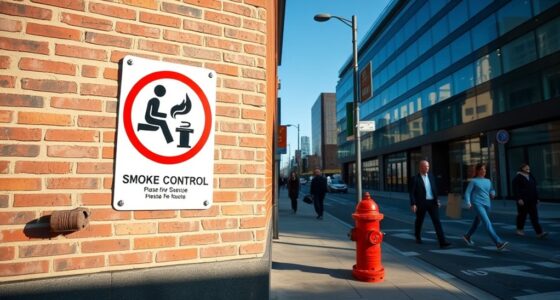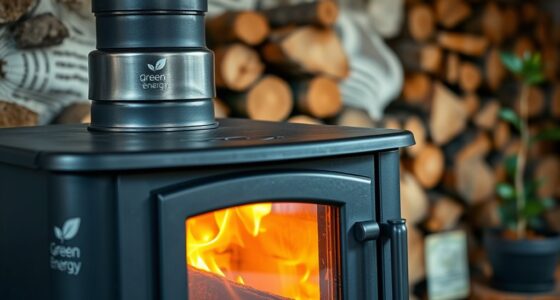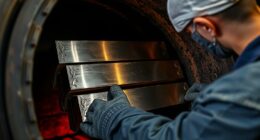Wood stoves can be environmentally friendly if you choose models with modern clean burn technology, use sustainably sourced wood, and follow proper firing techniques. They emit markedly fewer particles and pollutants today compared to older, inefficient stoves, helping reduce air pollution and carbon footprint. Proper maintenance and eco-friendly practices are key to minimizing environmental impact. If you want to understand how to make your wood stove more eco-conscious, there’s more to explore that can help you make better choices.
Key Takeaways
- Modern certified wood stoves emit significantly fewer particles, reducing air pollution compared to older models.
- When sourced sustainably, wood acts as a renewable energy, balancing carbon emissions through reforestation.
- Proper maintenance and advanced combustion technology ensure more complete burning, lowering harmful emissions.
- Using sustainably harvested wood minimizes environmental impact and supports responsible forest management.
- Implementing strict emission standards and promoting eco-friendly stoves help align wood burning with environmental goals.
Understanding the Carbon Cycle and Sustainability of Wood Burning

Understanding the carbon cycle is crucial to evaluating the sustainability of wood burning. Trees absorb about 1.8 to 2.5 tonnes of CO₂ per hectare each year, acting as natural carbon sinks. When you burn wood, it releases the same amount of CO₂, creating a balanced cycle if sourced responsibly. Sustainable forest management ensures replanting matches or exceeds harvesting, maintaining a renewable resource. Proper reforestation prevents deforestation and supports continuous CO₂ absorption, which is essential for achieving carbon neutrality. When managed correctly, wood can be considered a renewable energy source because its use doesn’t increase atmospheric CO₂ over time. By understanding this cycle and practicing responsible harvesting, you help ensure that wood remains an environmentally friendly option within a sustainable forest system.
The Environmental Impact of Modern and Old-Style Wood Stoves

Older wood stoves and fireplaces, often called non-clean burn models, release large amounts of airborne dust and particulate matter, markedly worsening air pollution. Burning wood in these outdated stoves results in high particulate emissions due to incomplete combustion, especially in poorly ventilated units. Modern stoves, approved by authorities, significantly reduce pollution, emitting as little as 5 grams of particles per hour. These advanced models improve combustion efficiency, decreasing PM2.5 and soot release. Additionally, filtration systems incorporated in some modern stoves help capture fine particles before they are emitted into the air. Moreover, proper maintenance practices are essential to ensure efficient and clean operation, further reducing emissions. However, some new stoves still produce hundreds of times more PM2.5 than regulated diesel HGVs, raising ongoing environmental concerns. While modern stoves are a step forward, burning wood in older models remains detrimental to air quality, contributing substantially to airborne dust and particulate pollution that impacts both local and regional environments. Research on custodian services for Gold IRA management highlights the importance of choosing reliable providers to maintain asset security. Additionally, efficiency and proper usage can further influence the environmental impact of wood stove burning. Proper ventilation also plays a critical role in reducing emissions and improving indoor air quality, aligning with best practices for safe wood stove operation.
Advances in Clean Burn Technology and Emission Reduction
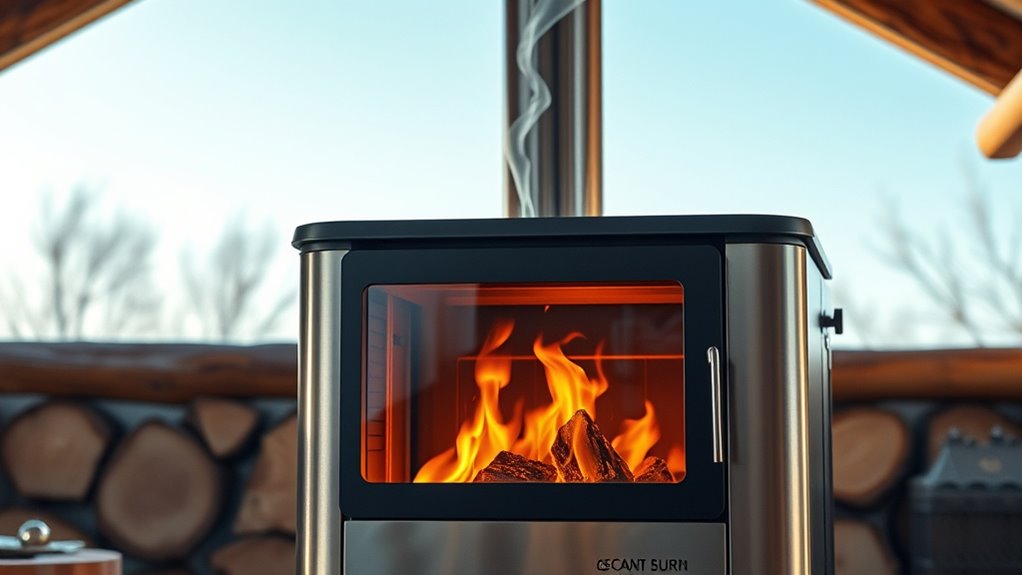
Advances in clean burn technology have revolutionized how you use wood stoves, dramatically reducing harmful emissions. Modern clean burn stoves emit as little as 5 grams of particulate emissions per hour, thanks to improved stove technology that ensures more complete combustion. By providing proper oxygen supply during burning, these stoves decrease particulate emissions by up to six times compared to older models, helping improve air quality. Certification schemes like clearSkies promote the adoption of low-emission appliances that meet higher standards than regulatory Ecodesign requirements. Countries like Norway, which mandated clean burn stoves in 1998, have seen widespread benefits. These technological innovations are essential for emission reduction, making wood stoves a more environmentally friendly heating option while protecting your health and the environment.
Balancing Cultural Traditions With Environmental and Health Concerns
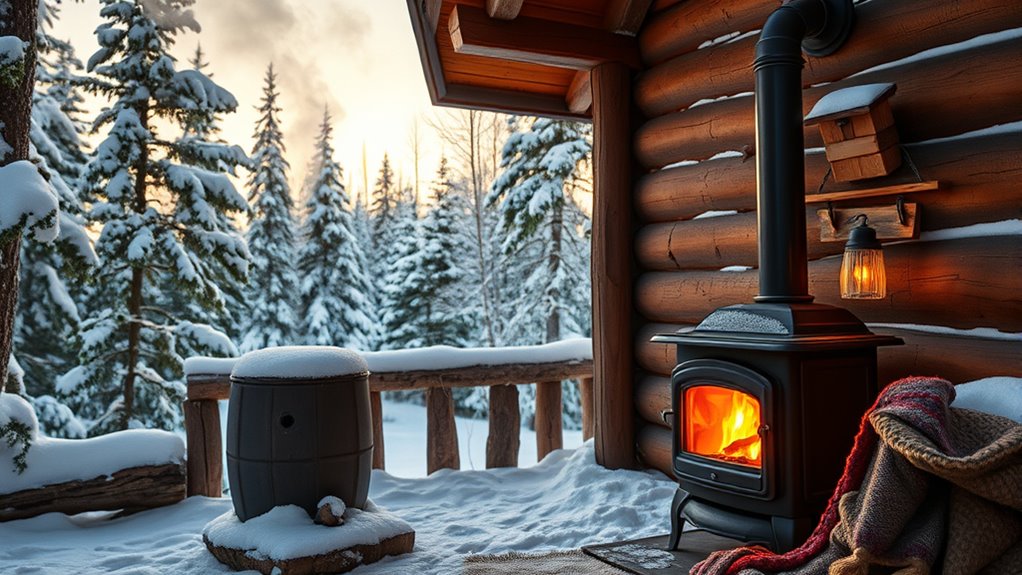
While modern clean burn technology has markedly reduced emissions from wood stoves, many communities still value the cultural traditions surrounding wood burning. These traditions provide warmth, nostalgia, and a sense of community that’s hard to replace. However, old wood stoves release high levels of airborne particles, contributing to local air pollution and health risks. Sustainable sourcing of wood also helps reduce pollution. Promoting the use of low-emission wood stoves can significantly decrease particulate matter released into the atmosphere. Proper stove maintenance and choosing efficient models further enhance environmental benefits. Additionally, implementing emission standards can help ensure that new and existing stoves meet safety and environmental requirements. Balancing these cultural practices with environmental concerns means encouraging the use of certified, low-emission stoves that meet strict emission standards. While some stoves still emit hundreds of times more PM2.5 than diesel trucks, efforts to promote environmentally friendly options aim to preserve cultural traditions without compromising health or the environment. Finding this balance is key to respecting heritage while protecting air quality.
Making Eco-Friendly Choices: Is a Wood Stove the Right Option?

Deciding if a wood stove is an eco-friendly choice depends on several factors, including the type of stove you use and how you operate it. Modern wood burning stoves with advanced technology can emit as little as 5 grams of particles per hour, greatly lowering emissions. Certified stoves that meet strict standards, like Ecodesign, produce far fewer pollutants than older models. Using sustainably sourced wood further reduces your carbon footprint, making your choice more environmentally friendly. Proper firing techniques ensure efficient combustion, decreasing harmful emissions and energy waste. Additionally, vetted wood stove products are tested for safety and efficiency, helping you make an informed decision. Incorporating the principles of the Law of Attraction can also help you align your choices with your environmental values and goals. Selecting eco-friendly heating options may be more suitable in urban areas with higher pollution levels from wood burning, which can significantly impact air quality. Being aware of the environmental impacts of wood-burning can guide you toward more sustainable choices that minimize deforestation and pollution. Advances in AI-driven security systems also contribute to safer, smarter homes that support eco-conscious living, reinforcing the importance of choosing sustainable technologies. Weighing these factors helps you decide if a wood stove aligns with your eco-conscious goals.
Frequently Asked Questions
Are Wood-Burning Stoves Better for the Environment?
You wonder if wood-burning stoves are better for the environment. While they’re considered carbon-neutral, they still emit significant particles, especially PM2.5, which can harm air quality and health. Modern stoves reduce emissions, but regulation standards are weak. Using sustainably sourced wood and clean burning practices can help, but overall, they’re not as environmentally friendly as other options like electric heating or gas.
What Is Negative About a Wood Burning Stove?
You should know that wood-burning stoves have significant drawbacks. They emit high levels of PM2.5 particles, which harm your health and can enter your bloodstream. Even modern ‘eco’ stoves release particles far exceeding vehicle emissions. Indoor air pollution increases, risking respiratory issues. Plus, despite being renewable, they contribute heavily to local pollution and climate change through soot and particulate matter, making them less environmentally friendly.
What Is the Biggest Drawback to Heating With Wood?
The biggest drawback to heating with wood is that it’s like burning a cloud of pollution in your home and outside. You might save money and enjoy the cozy feel, but you also release high levels of PM2.5 particles, which harm your health and the environment. Even modern stoves cannot fully eliminate these emissions, making wood heating a trade-off between comfort and pollution.
Why Is the Burning of Wood Not Eco-Friendly?
You might think burning wood is eco-friendly, but it actually isn’t. When you burn wood, you release tiny soot particles called PM2.5, which harm air quality and contribute to climate change. Even newer stoves still emit high levels of pollution. These emissions can cause serious health issues like respiratory problems and cancer, making wood burning far from environmentally friendly, especially in urban areas where pollution from wood can be worse than traffic.
Conclusion
Ultimately, choosing a wood stove is like walking a tightrope between tradition and sustainability. While modern technology can reduce emissions, it’s your choices that tip the balance. If you’re committed to eco-friendly living, consider cleaner-burning models and responsible sourcing. By making informed decisions, you can enjoy the cozy glow of a wood stove without casting a shadow on the environment. It’s about lighting a fire that warms your home—and the planet’s future.




